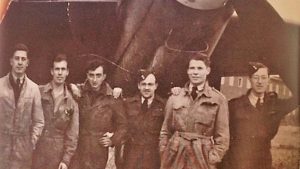 We had the absolute pleasure of taking 99-year-old (soon to be 100) George Pritchard on a flight around some of his old Cambridgeshire WW2 Airfields, including former RAF Bourn, Wyton and Alconbury, with a flypast of Duxford IWM landing finally at Fowlmere. WW2 Pilot F/Sgt George Pritchard was a Wellington pilot and then a Mosquito pilot with 544Sqn during WW2. He ended the war with 140 Wing flying rocket Mosquitos in Europe. George flew the Harvard several times during his training 80 years ago. Flying with George in the Wacky Wabbit Harvard was an absolute pleasure. (George above 5th from left to right)
We had the absolute pleasure of taking 99-year-old (soon to be 100) George Pritchard on a flight around some of his old Cambridgeshire WW2 Airfields, including former RAF Bourn, Wyton and Alconbury, with a flypast of Duxford IWM landing finally at Fowlmere. WW2 Pilot F/Sgt George Pritchard was a Wellington pilot and then a Mosquito pilot with 544Sqn during WW2. He ended the war with 140 Wing flying rocket Mosquitos in Europe. George flew the Harvard several times during his training 80 years ago. Flying with George in the Wacky Wabbit Harvard was an absolute pleasure. (George above 5th from left to right)
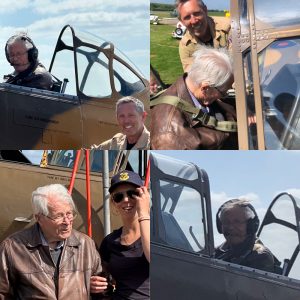 Emotional: This was a hectic and nostalgic day for him, and it was no surprise that he could remember everything about flying the Harvard. A fantastic day with friends and family, he was finished in style with a couple of pints and a big dinner in our local pub, ‘Chequers’ in Fowlmere, a pub familiar to any pilot from the Battle of Britain based at Fowlmere.
Emotional: This was a hectic and nostalgic day for him, and it was no surprise that he could remember everything about flying the Harvard. A fantastic day with friends and family, he was finished in style with a couple of pints and a big dinner in our local pub, ‘Chequers’ in Fowlmere, a pub familiar to any pilot from the Battle of Britain based at Fowlmere.
Read Georges’s book “Here we go again” Buy this on Amazon.
By 18, he was a pilot in a Mosquito unit. His simple ambitions and motivation were shared by his comrades – to survive! Although a traumatic period of history, humour and inspiration was always to be found, and this is the focus of many of the anecdotes shared by George in his memoirs.
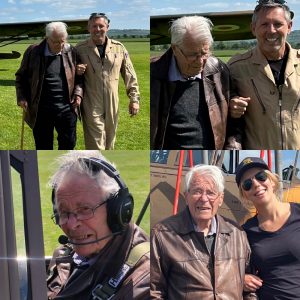 This intriguing and captivating read invites you into George’s world, sharing his joyful times, sorrow, and stories of wonderful friends, family, and events. His innovative designs helped save lives in medicine and beyond, being involved in developing the ‘pacemaker’ and ‘heart-lung’ machine, and a consultant for Nuclear Power, amongst many other things.
This intriguing and captivating read invites you into George’s world, sharing his joyful times, sorrow, and stories of wonderful friends, family, and events. His innovative designs helped save lives in medicine and beyond, being involved in developing the ‘pacemaker’ and ‘heart-lung’ machine, and a consultant for Nuclear Power, amongst many other things.
“When I look back, I think ‘, why wasn’t I scared out of my mind’?” says 99-year-old George Pritchard, a former PRU pilot. “But I wasn’t scared at all.”
By all accounts, he should have been scared. Their planes were unarmed and stripped down, which, while helping them outpace the enemy, left them more vulnerable to attack. The survival rate in the unit was proportionally the second lowest of any Allied aerial team during the entire war. “At three o’clock in the morning, we woke up with a cup of tea,” he says. “We would dive straight into our flying suits. It would be a miserable morning with thick mists, rain, and dense clouds. “We’d head down the runway, taxi round the perimeter, and take off hell for leather completely blind.
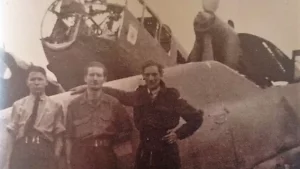 “You could just about make out the runway between the lights.” Once the planes took off, Mr Pritchard says, they would reach 21,000ft (6,400m) before dropping to around 3,000ft (914m) to take pictures. With one eye on fuel, the pilots would return to base after completing their mission. “When we landed, the cameras would be taken off, and we’d have egg and bacon,” Mr Pritchard says. “You’d get two hours sleep and report back for the next operation.” (Right – George on the left)
“You could just about make out the runway between the lights.” Once the planes took off, Mr Pritchard says, they would reach 21,000ft (6,400m) before dropping to around 3,000ft (914m) to take pictures. With one eye on fuel, the pilots would return to base after completing their mission. “When we landed, the cameras would be taken off, and we’d have egg and bacon,” Mr Pritchard says. “You’d get two hours sleep and report back for the next operation.” (Right – George on the left)
Mr Pritchard’s desire to serve as a pilot was sparked one day in August 1940.
Then aged just 16, he had a job making ammunition boxes for the Acme Corrugated Cardboard Company, based on the edge of Croydon Airfield. He remembers begging his then-foreman for overtime but was told he was too young and had to head home instead. Once there, he joined his mother and father in their garden, overlooking the airport. Mr Pritchard remembers seeing planes overhead and what his father thought were parachutes coming out of them. “A matter of seconds” Later, he says, explosions rang out. The parachutes had been bombs.
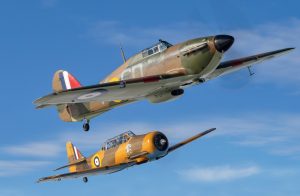 “Hurricanes came and chased them off or shot them down as I understand it,” he says. “I rode back to work, and there was a policeman there. I said, ‘I work at Acme’ he said, ‘You used to; you don’t any longer; it’s no longer there’.” All of his friends and workmates had been killed in the bombing. “I stood there as a 16-year-old, and I cried,” he says. “I made my mind up, absolutely definitely, that I was going to join the RAF and get my own back.” If his foreman had bent the rules and allowed him to continue working, he would have died along with everyone else. By 17, Mr Pritchard had joined the RAF and eventually became a PRU pilot. Of his 22-strong joining cohort, only Mr Pritchard would survive the war. Those lost included his best friend.
“Hurricanes came and chased them off or shot them down as I understand it,” he says. “I rode back to work, and there was a policeman there. I said, ‘I work at Acme’ he said, ‘You used to; you don’t any longer; it’s no longer there’.” All of his friends and workmates had been killed in the bombing. “I stood there as a 16-year-old, and I cried,” he says. “I made my mind up, absolutely definitely, that I was going to join the RAF and get my own back.” If his foreman had bent the rules and allowed him to continue working, he would have died along with everyone else. By 17, Mr Pritchard had joined the RAF and eventually became a PRU pilot. Of his 22-strong joining cohort, only Mr Pritchard would survive the war. Those lost included his best friend.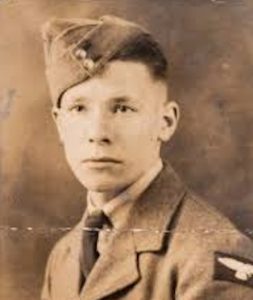
“You were young, and you thought it would happen to everyone else but not you,” he says. “You have to have that; otherwise, you will run away. “I didn’t think I was going to live. I thought I would catch it sooner or later. You would have guys there one morning, and then you didn’t. “You got the feeling if your number’s in the book, you will get it that day or time, so why worry in the meanwhile.” The war left harsh memories, though.
Mr Pritchard remembers one occasion when he was gripped with fear while walking through Notting Hill Gate underground station. “I ran up 300 steps and collapsed on the pavement,” he says. “I went to the doctor, and he said it was a build-up of stress over time. “A vast number of pilots were murdered on the orders of Hitler.
They were either hanged or shot. “Nobody remembers them; how could they? “It’s a perfect thing to do to remember people who gave their lives up. I was just one of the lucky ones.”
Below is a photo dump of the day with George!
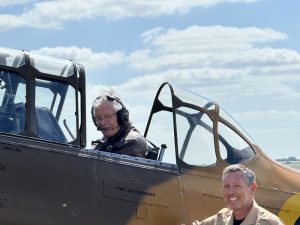 George Pritchard has boarded the T6 Harvard for his first Harvard flight in 80 years with pilot Andy Goodall. George wasn’t a fan of the Harvard in WW2, but then again, he flew Mosquitos!
George Pritchard has boarded the T6 Harvard for his first Harvard flight in 80 years with pilot Andy Goodall. George wasn’t a fan of the Harvard in WW2, but then again, he flew Mosquitos!
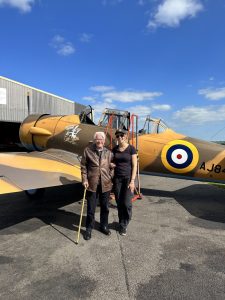 Megan takes the opportunity for a photo before George climbs into the Harvard.
Megan takes the opportunity for a photo before George climbs into the Harvard.
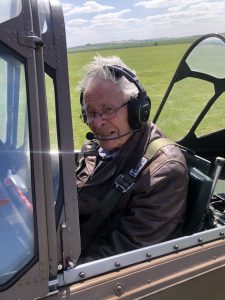
George safely back down to earth!
#mosquito #flying #veteran #aviation #GeorgePritchard PRU pilot, George Pritchard Photo reconnaissance unit pilot, George Pritchard, a former PRU pilot from the Photo reconnaissance unit, George Pritchard RAF club member and former PRU reconnaissance unit pilot in de Havilland DH.98 Mosquito Mosquitos.